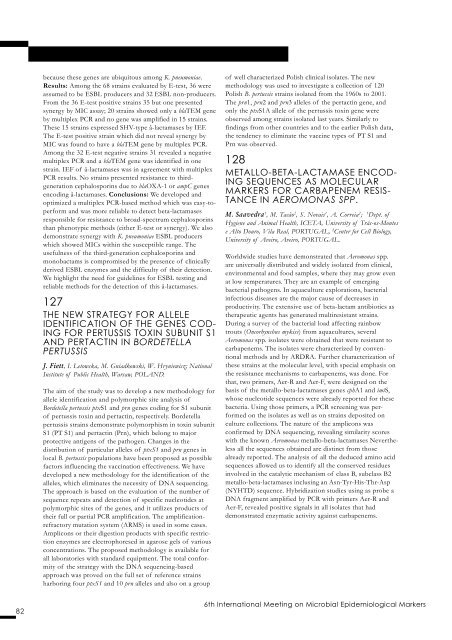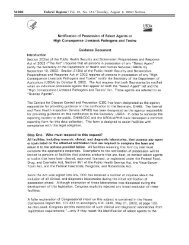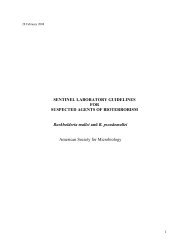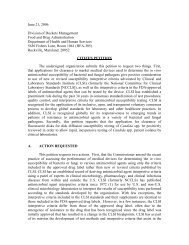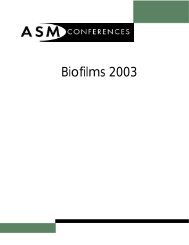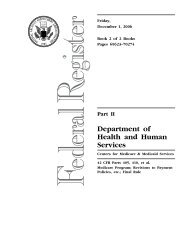Program and Abstract Book - Microbiology
Program and Abstract Book - Microbiology
Program and Abstract Book - Microbiology
You also want an ePaper? Increase the reach of your titles
YUMPU automatically turns print PDFs into web optimized ePapers that Google loves.
POSTER SESSION Bbecause these genes are ubiquitous among K. pneumoniae.Results: Among the 68 strains evaluated by E-test, 36 wereassumed to be ESBL producers <strong>and</strong> 32 ESBL non-producers.From the 36 E-test positive strains 35 but one presentedsynergy by MIC assay; 20 strains showed only a blaTEM geneby multiplex PCR <strong>and</strong> no gene was amplified in 15 strains.These 15 strains expressed SHV-type â-lactamases by IEF.The E-test positive strain which did not reveal synergy byMIC was found to have a blaTEM gene by multiplex PCR.Among the 32 E-test negative strains 31 revealed a negativemultiplex PCR <strong>and</strong> a blaTEM gene was identified in onestrain. IEF of â-lactamases was in agreement with multiplexPCR results. No strains presented resistance to thirdgenerationcephalosporins due to blaOXA-1 or ampC genesencoding â-lactamases. Conclusions: We developed <strong>and</strong>optimized a multiplex PCR-based method which was easy-toperform<strong>and</strong> was more reliable to detect beta-lactamasesresponsible for resistance to broad-spectrum cephalosporinsthan phenotypic methods (either E-test or synergy). We alsodemonstrate synergy with K. pneumoniae ESBL producerswhich showed MICs within the susceptible range. Theusefulness of the third-generation cephalosporins <strong>and</strong>monobactams is compromised by the presence of clinicallyderived ESBL enzymes <strong>and</strong> the difficulty of their detection.We highlight the need for guidelines for ESBL testing <strong>and</strong>reliable methods for the detection of this â-lactamases.127THE NEW STRATEGY FOR ALLELEIDENTIFICATION OF THE GENES COD-ING FOR PERTUSSIS TOXIN SUBUNIT S1AND PERTACTIN IN BORDETELLAPERTUSSISJ. Fiett, I. Letowska, M. Gniadkowski, W. Hryniewicz; NationalInstitute of Public Health, Warsaw, POLAND.The aim of the study was to develop a new methodology forallele identification <strong>and</strong> polymorphic site analysis ofBordetella pertussis ptxS1 <strong>and</strong> prn genes coding for S1 subunitof pertussis toxin <strong>and</strong> pertactin, respectively. Bordetellapertussis strains demonstrate polymorphism in toxin subunitS1 (PT S1) <strong>and</strong> pertactin (Prn), which belong to majorprotective antigens of the pathogen. Changes in thedistribution of particular alleles of ptxS1 <strong>and</strong> prn genes inlocal B. pertussis populations have been proposed as possiblefactors influencing the vaccination effectiveness. We havedeveloped a new methodology for the identification of thealleles, which eliminates the necessity of DNA sequencing.The approach is based on the evaluation of the number ofsequence repeats <strong>and</strong> detection of specific nucleotides atpolymorphic sites of the genes, <strong>and</strong> it utilizes products oftheir full or partial PCR amplification. The amplificationrefractorymutation system (ARMS) is used in some cases.Amplicons or their digestion products with specific restrictionenzymes are electrophoresed in agarose gels of variousconcentrations. The proposed methodology is available forall laboratories with st<strong>and</strong>ard equipment. The total conformityof the strategy with the DNA sequencing-basedapproach was proved on the full set of reference strainsharboring four ptxS1 <strong>and</strong> 10 prn alleles <strong>and</strong> also on a groupof well characterized Polish clinical isolates. The newmethodology was used to investigate a collection of 120Polish B. pertussis strains isolated from the 1960s to 2001.The prn1, prn2 <strong>and</strong> prn3 alleles of the pertactin gene, <strong>and</strong>only the ptxS1A allele of the pertussis toxin gene wereobserved among strains isolated last years. Similarly tofindings from other countries <strong>and</strong> to the earlier Polish data,the tendency to eliminate the vaccine types of PT S1 <strong>and</strong>Prn was observed.128METALLO-BETA-LACTAMASE ENCOD-ING SEQUENCES AS MOLECULARMARKERS FOR CARBAPENEM RESIS-TANCE IN AEROMONAS SPP.M. Saavedra 1 , M. Tacão 2 , S. Novais 1 , A. Correia 2 ; 1 Dept. ofHygiene <strong>and</strong> Animal Health, ICETA, University of Trás-os-Montese Alto Douro, Vila Real, PORTUGAL, 2 Center for Cell Biology,University of Aveiro, Aveiro, PORTUGAL.Worldwide studies have demonstrated that Aeromonas spp.are universally distributed <strong>and</strong> widely isolated from clinical,environmental <strong>and</strong> food samples, where they may grow evenat low temperatures. They are an example of emergingbacterial pathogens. In aquaculture explorations, bacterialinfectious diseases are the major cause of decreases inproductivity. The extensive use of beta-lactam antibiotics astherapeutic agents has generated multiresistant strains.During a survey of the bacterial load affecting rainbowtrouts (Oncorhynchus mykiss) from aquacultures, severalAeromonas spp. isolates were obtained that were resistant tocarbapenems. The isolates were characterized by conventionalmethods <strong>and</strong> by ARDRA. Further characterization ofthese strains at the molecular level, with special emphasis onthe resistance mechanisms to carbapenems, was done. Forthat, two primers, Aer-R <strong>and</strong> Aer-F, were designed on thebasis of the metallo-beta-lactamases genes cphA1 <strong>and</strong> imiS,whose nucleotide sequences were already reported for thesebacteria. Using those primers, a PCR screening was performedon the isolates as well as on strains deposited onculture collections. The nature of the amplicons wasconfirmed by DNA sequencing, revealing similarity scoreswith the known Aeromonas metallo-beta-lactamases Neverthelessall the sequences obtained are distinct from thosealready reported. The analysis of all the deduced amino acidsequences allowed us to identify all the conserved residuesinvolved in the catalytic mechanism of class B, subclass B2metallo-beta-lactamases inclusing an Asn-Tyr-His-Thr-Asp(NYHTD) sequence. Hybridization studies using as probe aDNA fragment amplified by PCR with primers Aer-R <strong>and</strong>Aer-F, revealed positive signals in all isolates that haddemonstrated enzymatic activity against carbapenems.826th International Meeting on Microbial Epidemiological Markers


